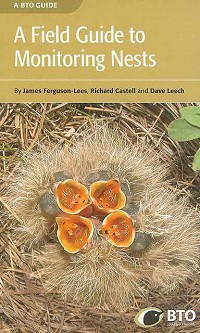A Field Guide to Monitoring Nests by James Ferguson-Lees, Richard Castell and David Leech

Carried out in the correct manner, nest recording can prove invaluable, filling in the missing links between other studies such as ringing and the field-based Breeding Bird Surveys. A Field Guide to Monitoring Nests has been written by some of the most knowledgeable and experienced nest experts around. It is split into two parts: the first acts as the essential nest-recorder's manual, explaining exactly why nests need to be studied, detailing the BTO's Nest Recording Scheme, and providing essential reading covering all areas of nest-recording good practice. As a basic outline, the following points must be observed by all nest-recorders:
- Plan your visit — keep the amount of time spent at a nest to a minimum.
- Take care whilst searching — check carefully where you position your feet; a surprising number of species nest on the ground.
- Don't leave any evidence of your visit.
- Approach with care.
- Check for sitting birds — nests should be approached when unattended to avoid startling a sitting bird.
- Be careful when monitoring large chicks — startled chicks may scatter from the nest.
- And most importantly, only visit a nest to collect scientific data — a nest should not be visited at other times nor for other purposes.
Full details of how to carry out all of the above responsibly are given in the book.
The second section of the book details all that is currently known about 146 British breeding species and is likely to appeal to both the nest-finder and the keen field birder. It includes information on habitat and site selection, timing, nest building, incubation and brooding, and methods on how best to detect nearby breeding for each species.
All in all this is an excellent book, undoubtedly invaluable to those who carry out nest-monitoring but likely extremely interesting to anyone who simply wants to learn more about the breeding behaviour of Britain's birds, too.
Softcover, 272 pages; maps, diagrams and colour photographs throughout; published by British Trust for Ornithology 2011, ISBN-13: 978-1-906204-79-2. Available on the BTO website.


